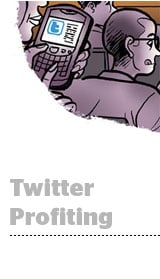 Here’s today’s AdExchanger.com news round-up… Want it by email? Sign-up here.
Here’s today’s AdExchanger.com news round-up… Want it by email? Sign-up here.
Twitter’s Bottomless Profit
In a flattering profile of the Twitter ads team, which has been relatively untouched during recent executive machinations, The NY Times’ Bits blog sees a profitable future for the social (ad) platform. Twitter’s Adam Bain and Kevin Weil are given props as the NYT’s writers conclude: “Ultimately, even if Twitter never adds another user, most analysts expect that Mr. Bain and his team could keep increasing revenue for some time just by showing more and better ads to current users, especially internationally, where very few ads appear in the main feed.” Read more. The last major ads-related departure was Satya Patel, who was VP of product at Twitter from 2011-2012 – eons ago in Internet years.
The Investing Movement
Angel investor and bon vivant Jerry Neumann puts his barbecue tongs down just long enough over the Fourth of July holiday to deliver a tome on venture capital investing – i.e., betting. From his personal blog, he reminds readers that the big win$ are rare and adds, “We should be so lucky to see another tech movement like electricity or mass manufacturing or the internet again in our lifetimes. The really big ones come once every couple of generations. But the big-but-not-enormous ones come all the time. Mobile, programmatic advertising, big data and 3-D printing are all examples of technological movements that are big enough to sustain an ecosystem of companies…” Read more.
36% Fraud, 50% Not Viewed
In an interview published Friday with Joe Mandese of MediaPost, GroupM’s Ari Bluman revisits – and continues to stand behind – his media-buying group’s decision to stop buying through open exchanges. Part of the interview: “Mandese: You’re saying you want to stay out of the riffraff, the long-tail of online audiences. But that riffraff is your audience. Consumers are on pages that ads are being served to. Bluman: Hopefully, but 36% of it is fraud and 50% of it’s not viewed.” Read it.
Owning The Content
The big Internet “pipes” companies continue to circle the wagons around content. Apparently, Amazon has some catching up to do where streaming video is concerned, according to analysts from Piper Jaffray. “While significantly inferior to Netflix, and even more to Hulu, we believe Amazon is driving video in the right direction by focusing on TV shows,” said analyst Gene Munster. “TV series are easier to acquire, as the contracts tend to be non-exclusive and less locked up than movie content.” Munster mentioned that Netflix’s original series buy the company an advantage. Read more via The Wall Street Journal (subscription)l. Related: Meredith is taking its online recipes site Allrecipes and pitching TV show ideas. Read that one.
What’s The Frequency, Kenneth?
Facebook’s reach and frequency metrics for June may be off for some Facebook page owners. Inside Facebook sources the report and says Facebook has posted the following message to some page admins: “There is a discrepancy in the engagement and reach metrics for all Page Posts and Boosted Posts between 5/30 and 6/30. We are working to resolve the issue as soon as possible…” Read it. That’s going to be a bit of double-work for whoever’s in charge of your social ad stats.
Automating The Tube
As the ad tech industry ventures deeper down the digitalization rabbit hole, TV advertising may need to reimagine its processes, says David Cooperstein, Simulmedia CMO and former Forrester VP. In a contributing feature for Forbes, Cooperstein suggests automation is key. “I am not saying that TV needs to become digital in terms of interactivity,” writes Cooperstein, “but it does need to become a digital business in the context of improving the processes that a) make the buying process simpler and b) unlock revenues that are held back by current practices and technology. What better way to do that then to automate buys across networks, tie impressions to results, and market to people rather than broadly defined audiences?” Read more.
Total, Tablet Ad, Recall
Serving ads on tablets is as efficient as serving ads in print magazines, according to a study by GfK released on Thursday. GfK’s MRI Starch Advertising Research unit surveyed nearly 29,000 ads across 805 tablets published in 2013. Research showed that ads in tablet versions of magazines and those same ads in print both yielded a 52% level of recall. The data suggests that tablet-edition ads have yet to leverage digital advantages over print advertisements. Read the release.
Goodbye!
- Longtime Wenner Media Execs Quit – Adweek
But Wait. There’s More!
- Amazon Mobile Ad Network Expands To Germany And France – Amazon Developer blog
- A Different Way Of Looking At Social Media Marketing – Digiday
- eBay-Owned E-Commerce Platform Magento Shuts Down SMB Services – TechCrunch
- Mobile Ad Tech Startup Adtile Raises $4.5 Million In Series A Round – VentureBeat
- Snapchat Goes Local: Firm Tests ‘Stickers’ For Potential Branding – The Daily Mail
- Publicis Groupe Acquires UK-Based Salterbaxter – press release
- Celtra’s In-App Cross-Screen Measuring Just Got Better – Mobile Marketing Watch










